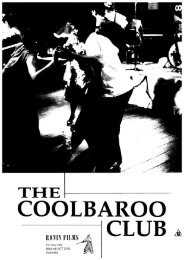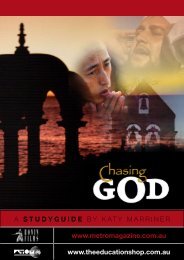to download SALUTE study guide - Ronin Films
to download SALUTE study guide - Ronin Films
to download SALUTE study guide - Ronin Films
Create successful ePaper yourself
Turn your PDF publications into a flip-book with our unique Google optimized e-Paper software.
A STUDY GUIDE by Robert Lewis<br />
http://www.metromagazine.com.au<br />
http://www.theeducationshop.com.au
Overview<br />
The picture of the three men on<br />
the winner’s podium after the<br />
Men’s 200m final at the 1968<br />
Mexico City Olympics is still<br />
considered one of the most<br />
powerful images of modern<br />
his<strong>to</strong>ry. Almost forgotten in the<br />
ensuing years is the seemingly<br />
quiet and composed man in the<br />
left of the picture, the Australian<br />
silver medallist Peter Norman.<br />
Why is he considered a<br />
household name throughout the<br />
United States even <strong>to</strong>day<br />
And why do the other medallists<br />
Tommie Smith and John Carlos<br />
consider him a brother<br />
Salute (Matt Norman, 2008) is<br />
the ninety-minute s<strong>to</strong>ry of the<br />
quiet man, the forgotten man<br />
and a salute <strong>to</strong> him.<br />
Curriculum Applicability<br />
Salute is suitable for senior<br />
students in:<br />
• American His<strong>to</strong>ry<br />
• Society and Environment<br />
• Values Education<br />
• Politics<br />
• English.<br />
Before watching<br />
the film<br />
Look at the images above and<br />
answer these questions. You<br />
should discuss your answers in<br />
class.<br />
http://africanhis<strong>to</strong>rymonth.ligali.<br />
org/gallery.phpht=3<br />
1 Describe what is happening.<br />
2 Identify who is involved.<br />
3 At what event is it happening<br />
4 The pho<strong>to</strong>graphs are of a<br />
protest. What do you think<br />
is being protested for or<br />
against<br />
5 What aspects of or symbols<br />
in the images lead you <strong>to</strong><br />
believe this<br />
6 This is a very famous image.<br />
Why do you think it would be<br />
famous<br />
7 What do you think is the<br />
message of the pho<strong>to</strong>graph<br />
Now show the pho<strong>to</strong>graphs<br />
<strong>to</strong> people who are older than<br />
http://schol.wordpress.com/<br />
2008/02/25/1968-black-power<br />
-salute/<br />
about 55. Ask them questions<br />
1-7 above <strong>to</strong> see if they know<br />
what the pho<strong>to</strong>graph shows,<br />
and what they say is the<br />
meaning.<br />
Discuss your findings<br />
in class.<br />
You are about <strong>to</strong> find out about<br />
the events in this pho<strong>to</strong>graph.<br />
You will see that there are<br />
several symbolic elements in<br />
the pho<strong>to</strong>graph.<br />
8 Look closely and decide<br />
what these might be.<br />
9 Now look at the box on<br />
page 3 <strong>to</strong> see what the<br />
participants saw as the key<br />
symbolic elements.<br />
SCREEN EDUCATION 2
The key symbolic elements in the pho<strong>to</strong>graph are:<br />
- The clenched fists<br />
- The black gloves<br />
- The black silk scarf around the man on step numbered 1<br />
- The two black athletes are not wearing shoes<br />
- They are both wearing black socks<br />
- The two black athletes have each bowed his head<br />
- The two black athletes are each wearing a badge<br />
- The athlete on step 2 is also wearing a similar badge<br />
- The athlete on step 2 has not bowed his head.<br />
Now decide what each of these elements symbolizes.<br />
Does any of this change what you see as the key message or<br />
meaning of the pho<strong>to</strong>graph<br />
You will be able <strong>to</strong> come back <strong>to</strong> these symbols after watching<br />
the film.<br />
Background<br />
Salute is a journey back <strong>to</strong> the<br />
1960s <strong>to</strong> examine what has<br />
now become one of the most<br />
famous Olympic moments in<br />
his<strong>to</strong>ry.<br />
During this era the world was<br />
just three years away from<br />
the Cuban missile crisis and<br />
the threat of nuclear war,<br />
the horror of Vietnam, the<br />
assassinations of John F. and<br />
Robert Kennedy, Malcolm X and<br />
Martin Luther King. Frightened<br />
and desperate people were<br />
rioting in the streets of Europe,<br />
and throughout the U.S. where<br />
there was an urgent push for<br />
civil rights. Black nations were<br />
SCREEN EDUCATION 3
threatening <strong>to</strong> boycott the<br />
Olympics in protest and black<br />
athletes within the United States<br />
team were being urged <strong>to</strong><br />
boycott the Games.<br />
In<strong>to</strong> this atmosphere walked<br />
Peter Norman, whose<br />
performance had taken the<br />
US team by surprise. Who<br />
was this unknown sprinter<br />
from Australia He wasn’t a<br />
typical sprinter – he was quietly<br />
spoken, short-legged and white.<br />
In the 200-metres final, he ran<br />
the race of his life and split<br />
Tommie Smith and John Carlos,<br />
winning silver. As they waited<br />
for the presentation ceremony,<br />
Smith and Carlos <strong>to</strong>ld Peter of<br />
their plans. One had left behind<br />
his pair of black gloves, and at<br />
Peter’s suggestion, they wore<br />
one each.<br />
Despite it not being a situation<br />
that affected him directly, Peter<br />
asked the Americans if he could<br />
join their protest. He felt there<br />
was a moral imperative on him<br />
<strong>to</strong> stand up against something<br />
he felt was wrong. Like Tommie<br />
and John, Peter wore an<br />
Olympic Project for Human<br />
Rights badge in support of their<br />
silent protest.<br />
The image of the three of them<br />
on the dais, heads bowed, the<br />
Americans delivering the ‘Black<br />
Salute’, is regarded as one of<br />
the most powerful images of the<br />
twentieth Century.<br />
Lasting repercussions followed.<br />
Smith and Carlos were dropped<br />
from the relays and the team.<br />
They were kicked out of the<br />
Olympics and banned for life.<br />
Their lives were ruined, with<br />
Carlos’s wife later committing<br />
suicide.<br />
The punishment of Peter was<br />
less dramatic but ultimately<br />
as destructive. Coming from a<br />
conservative family in a country<br />
that still had a white only<br />
immigration policy, Norman’s<br />
stance caused a s<strong>to</strong>rm. He was<br />
hated in parts of the Australian<br />
establishment and the media<br />
turned on him.<br />
His chance <strong>to</strong> win gold at<br />
the 1972 Munich Olympics<br />
was s<strong>to</strong>len from him. Despite<br />
being the favourite <strong>to</strong> win gold,<br />
qualifying thirteen times for<br />
the 200m and five times for<br />
the 100m, the powers that be<br />
refused <strong>to</strong> take him <strong>to</strong> Munich.<br />
For the first time Australia was<br />
not represented in the sprint<br />
events at an Olympics.<br />
SCREEN EDUCATION 4
At the Sydney 2000 Olympics<br />
in Australia, Peter Norman was<br />
not invited <strong>to</strong> attend in any<br />
official capacity. Australia’s<br />
best sprinter ever, whose 200m<br />
Mexico games time of twenty<br />
seconds flat would have won<br />
the gold medal at Sydney and<br />
whose Australian record still<br />
stands nearly forty years later,<br />
wasn’t even invited <strong>to</strong> the 200m<br />
final by the Australian Olympic<br />
authorities. He was, however,<br />
invited by the U.S. team who<br />
flew him <strong>to</strong> Sydney and he was<br />
treated as an American guest.<br />
Due <strong>to</strong> his unique connection<br />
with the s<strong>to</strong>ry, Peter Norman’s<br />
nephew, Matt Norman,<br />
has been able <strong>to</strong> get an<br />
extraordinary level of access <strong>to</strong><br />
the three medallists and, for the<br />
first time, film all three of them<br />
<strong>to</strong>gether, talking about the event<br />
and the impact it had on their<br />
lives.<br />
Tragically Peter Norman died<br />
in Oc<strong>to</strong>ber 2006, soon after<br />
seeing a rough cut of the film.<br />
Both Smith and Carlos were<br />
pallbearers at Norman’s funeral.<br />
One of Peter’s last wishes was<br />
that his s<strong>to</strong>ry be <strong>to</strong>ld.<br />
SCREEN EDUCATION 5
Exploring Themes<br />
and Ideas<br />
The 1968 Olympics were held<br />
during a period of protest in the<br />
United States about the lack of<br />
rights and inequality of black<br />
people in American society.<br />
1 Describe the image of<br />
injustice that is presented in<br />
the film.<br />
2 The black athletes of the<br />
1968 team were originally<br />
going <strong>to</strong> boycott the Games.<br />
Why did they decide not <strong>to</strong><br />
do this<br />
3 A silent, peaceful protest<br />
might seem like an easy<br />
thing <strong>to</strong> do. Why was it<br />
in fact not easy What<br />
pressures existed on the<br />
athletes not <strong>to</strong> protest<br />
4 When John Carlos and<br />
Tommie Smith decided <strong>to</strong><br />
protest, what was Peter<br />
Norman’s reaction Why did<br />
he have this attitude<br />
5 What qualities did the three<br />
men show in carrying out<br />
their protest<br />
6 In the film Carlos and Smith<br />
speak about the fact that<br />
Norman <strong>to</strong>ok on an issue<br />
that need not have been his<br />
<strong>to</strong> take on, and that while<br />
they had each other for<br />
support, Norman was alone<br />
after the event <strong>to</strong> deal with<br />
its consequences. Why did<br />
Peter Norman choose <strong>to</strong><br />
become part of the protest<br />
Consider both his personal<br />
values, and the civil rights<br />
position of Indigenous<br />
Australians at this time.<br />
7 The film describes the<br />
symbolic elements of the<br />
protest:<br />
‘The symbolism went<br />
something along these<br />
lines: that the heads<br />
were obviously bowed<br />
in [acknowledgement of]<br />
brothers and sisters who had<br />
made the supreme sacrifice<br />
in the cause of African<br />
American Unity.’<br />
‘The raised arm and the<br />
clenched hand are a symbol<br />
of unity with the fingers<br />
coming <strong>to</strong>gether in a symbol<br />
of strength.’<br />
‘It was never meant as a<br />
threatening gesture.’<br />
‘The black socks that<br />
they wore throughout the<br />
competition, and [lack of]<br />
shoes, [were] a sign of<br />
African American poverty.’<br />
‘The fact that they couldn’t<br />
get jobs. They weren’t<br />
respected in jobs, they<br />
couldn’t get decent jobs.’<br />
‘They couldn’t get a decent<br />
education.’<br />
‘And all of this symbolism<br />
went … virtually by the board<br />
because they didn’t get a<br />
chance <strong>to</strong> explain it.’<br />
SCREEN EDUCATION 6
‘The press didn’t want <strong>to</strong><br />
hear about that, all they<br />
wanted <strong>to</strong> hear about were<br />
these militant young black<br />
athletes that had despoiled<br />
the Olympic dais.’<br />
Why were the symbols not<br />
clear <strong>to</strong> people at the time<br />
8 Look back at the pho<strong>to</strong>graph<br />
exercise. Do you think these<br />
symbols are there or not<br />
Discuss your reasons.<br />
9 One element of the 1960s<br />
in America which is not<br />
explored in the film is the<br />
threat of violent action and<br />
radical social change that<br />
existed in some parts of the<br />
black power movement.<br />
Some, though not all,<br />
Black Power adherents<br />
believed in racial separation,<br />
black nationalism, and the<br />
necessity <strong>to</strong> use violence as<br />
a means of achieving their<br />
aims. Such positions were<br />
for the most part in direct<br />
conflict with those of the<br />
leaders of the mainstream<br />
civil rights movement.<br />
One group in particular,<br />
the Black Panthers, were<br />
identified with the will and<br />
ability <strong>to</strong> use violence.<br />
Other elements, such as<br />
the followers of Malcolm X,<br />
the Muslim Brotherhood,<br />
challenged and threatened<br />
the idea of one America<br />
– they saw themselves as<br />
African and Muslim rather<br />
than American and Christian.<br />
How might the existence<br />
of such radical and even<br />
revolutionary elements in<br />
the black power movement<br />
have influenced people’s<br />
interpretation of the black<br />
power salute in Mexico in<br />
1968<br />
10 Any viewer of the film <strong>to</strong>day<br />
will be shocked by the<br />
treatment of the athletes<br />
after the protest. Why do you<br />
think both countries’ Olympic<br />
officials turned against the<br />
men How might they justify<br />
their actions Do you think it<br />
was justified<br />
11 The crea<strong>to</strong>rs of the memorial<br />
<strong>to</strong> the event in San Jose<br />
State University, California,<br />
included only two of the<br />
three figures involved in the<br />
1968 Mexico City protest.<br />
You can see a pho<strong>to</strong>graph<br />
of the statue at . Prepare<br />
an argument either that the<br />
statue should be left as it is,<br />
or that Peter Norman should<br />
be added <strong>to</strong> that statue. You<br />
should read the full article<br />
on the danvk.org website,<br />
and the associated article<br />
on the statue at .<br />
SCREEN EDUCATION 7
Thinking about <strong>to</strong>day<br />
Salute is a film about an international event in 1968. It has relevance for international events <strong>to</strong>day, as well<br />
as for individual reflection.<br />
2008: Is Beijing the place for protest<br />
There have been protests at many Olympic Games:<br />
1908 Irish athletes boycott the London Games in protest about Britain’s refusal <strong>to</strong> grant Ireland<br />
independence.<br />
1932 An Italian winner gave a fascist salute from the podium in Los Angeles.<br />
1936 Many Jewish athletes refused <strong>to</strong> attend the Berlin Olympics in protest against German racially<br />
discrimina<strong>to</strong>ry laws.<br />
1956 Czechoslovakian and Russian water polo athletes fought in the pool – Russia had recently<br />
invaded Czechoslovakia <strong>to</strong> impose a friendly government.<br />
1964 South Africa was banned from the Tokyo Games because of its racial laws.<br />
1968 A protest by Mexican students against the cost of the Games while social relief was needed led<br />
<strong>to</strong> the deaths of an estimated 200-300 people. American athletes Tommy Smith and John Carlos<br />
make the black power salute from the podium.<br />
1972 Palestinian Black September terrorists kill eleven Israeli athletes.<br />
1976 Twenty-six African and Caribbean countries boycott the Montreal Games in protest against New<br />
Zealand, which had played rugby in racially segregated South Africa, being allowed <strong>to</strong> compete.<br />
1980 Many countries, including the United States, and many individual athletes, boycotted the<br />
Moscow Games in protest against the Soviet invasion of Afghanistan.<br />
1984 Soviet countries boycotted the Los Angeles Games.<br />
2008 There are calls for athletes and nations <strong>to</strong> protest against China’s presence in and claims <strong>to</strong><br />
Tibet.<br />
Protests at the Games (You complete this box after August 2008.)<br />
SCREEN EDUCATION 8
The Olympic Games offer<br />
one time when the world is<br />
focused on one place and<br />
one nation. Modern Olympic<br />
Games are occasions for<br />
the host nation <strong>to</strong> present<br />
itself <strong>to</strong> the world in the<br />
most favourable light – they<br />
are vehicles for official<br />
propaganda, for the host<br />
nation <strong>to</strong> create a positive<br />
and favourable image of itself<br />
for the rest of the world.<br />
Each nation, however, has<br />
aspects of its society or<br />
politics that are less than<br />
perfect, and there are always<br />
some people who believe<br />
passionately in causes that<br />
are critical of the host nation.<br />
In 2008 there has been much<br />
protest against China’s claim<br />
<strong>to</strong> sovereignty of Tibet, and<br />
its policies that may be<br />
leading <strong>to</strong> the destruction of<br />
Tibetan culture. Legitimate<br />
and peaceful protests that<br />
are part of a free society are<br />
not allowed in China. Some<br />
athletes believe that China’s<br />
policies are a violation of<br />
human rights.<br />
Is it legitimate and<br />
appropriate for individuals<br />
<strong>to</strong> protest at an Olympic<br />
Games – for example by<br />
wearing particular symbols,<br />
or by carrying placards, or by<br />
behaving in a particular way<br />
at a medals ceremony<br />
1 Read the information in<br />
the box <strong>to</strong> the right about<br />
the Australian position,<br />
consider the arguments<br />
for and against such a<br />
right <strong>to</strong> protest, discuss<br />
them in class, and make<br />
your own decision.<br />
Australian Olympic chief Coates says<br />
podium protests possible in Beijing<br />
Australian Olympic chief John Coates said Saturday he believes there is a<br />
good chance some athletes will launch protests on the medal podium at the<br />
Beijing Olympics.<br />
‘It is a real possibility,’ Coates said following the Australian Olympic<br />
Committee’s annual general meeting.<br />
‘The IOC doesn’t want the competition <strong>to</strong> be prejudiced in any way by<br />
any demonstrations. They may happen and they’ll have <strong>to</strong> be dealt with<br />
depending on how serious they are.’<br />
China has been heavily criticized by world leaders for their human rights record<br />
and for their recent crackdown in Tibet. The Olympic <strong>to</strong>rch’s journey around<br />
the world was marred by protesters ahead of the Aug. 8–24 Games.<br />
Coates said there could be podium demonstrations in Beijing similar <strong>to</strong><br />
the black power protest on the medal podium by American track athletes<br />
Tommie Smith and John Carlos at the 1968 Olympics in Mexico City.<br />
Smith and Carlos raised their black-gloved fists and bowed their heads<br />
during the playing of ‘The Star-Spangled Banner’. Both were expelled from<br />
the games.<br />
Coates’ comments came as the AOC loosened its protest <strong>guide</strong>lines for<br />
Australian athletes at the Beijing Games. The new <strong>guide</strong>lines, announced at<br />
the annual general meeting, expand on protest rules issued during the week<br />
by the International Olympic Committee (IOC).<br />
The AOC says athletes must respect the dignity of the host nation China,<br />
their fellow athletes and the Olympic charter.<br />
But it said athletes were free <strong>to</strong> express their opinions on Tibet, human rights<br />
and other such issues in media interviews and online blogs, but cannot place<br />
protest signs or propaganda on clothing or equipment.<br />
It said any breach of the Olympic charter would result in disqualification from<br />
the Games.<br />
‘We don’t want banners and T-shirts and things in the village which is meant<br />
<strong>to</strong> be a place where 10,500 athletes get <strong>to</strong>gether,’ Coates said.<br />
You can imagine that if the Iraqi team turned up with T-shirts telling us and<br />
Britain and the U.S. <strong>to</strong> get out of Iraq, there could be some unpleasant things<br />
happen in the village. And similarly I think we have <strong>to</strong> respect the athletes of<br />
all countries, including China, in the village.<br />
12 May 2008<br />
http://www.iht.com/articles/2008/05/12/sports/oly12.php<br />
SCREEN EDUCATION 9
Personal protest<br />
action<br />
Most of us share a basic set of<br />
values such as the importance<br />
of honesty, the right <strong>to</strong> have a<br />
‘fair go’, the need <strong>to</strong> obey laws,<br />
access <strong>to</strong> a democratic system<br />
of government, and the right <strong>to</strong><br />
live in a free society.<br />
However, there are some values<br />
on which we disagree, and<br />
some policies and laws that we<br />
think may not be appropriate.<br />
We all have the right <strong>to</strong> try <strong>to</strong><br />
bring about change <strong>to</strong> these<br />
laws and policies through<br />
peaceful means.<br />
Trying <strong>to</strong> achieve change in our<br />
society is one aspect of active<br />
citizenship.<br />
We talk about active citizenship<br />
– but what can an active citizen<br />
do The table on page 11 lists<br />
some possibilities.<br />
2 In a small group, look at<br />
three or four of each of the<br />
possible ways of responding<br />
as a citizen <strong>to</strong> an issue.<br />
Make sure that between<br />
all groups you cover all the<br />
actions listed.<br />
3 Report on the main<br />
strengths and weaknesses<br />
of each possible action<br />
in bringing about change.<br />
In your report you should<br />
consider how different<br />
circumstances can<br />
influence the strengths and<br />
weaknesses of possible<br />
actions. For example,<br />
a petition signed by<br />
three people might have<br />
less influence than one<br />
signed by three million<br />
people! Or there might be<br />
circumstances in which a<br />
petition was more effective<br />
than a protest.<br />
You may also want <strong>to</strong> add some<br />
more possible actions <strong>to</strong> this<br />
list.<br />
SCREEN EDUCATION 10
Actions Strengths Weaknesses<br />
Vote in an election<br />
Join a political party<br />
Write letters <strong>to</strong> newspapers<br />
Petition parliament<br />
Do something <strong>to</strong> get media attention<br />
<strong>to</strong> the issue<br />
Protest publicly<br />
See your local MP<br />
Write <strong>to</strong> your local MP<br />
Write <strong>to</strong> the Minister<br />
Write <strong>to</strong> the PM<br />
Stand for parliament<br />
Boycott a product or event<br />
Strike<br />
Speak <strong>to</strong> others<br />
Lobby politicians<br />
Join a pressure group<br />
Do nothing<br />
Hand out leaflets<br />
Use passive resistance<br />
Use violence <strong>to</strong> draw attention <strong>to</strong> a<br />
cause<br />
SCREEN EDUCATION 11
4 Now decide as a class<br />
which ones (say the <strong>to</strong>p 3 or<br />
4) are likely <strong>to</strong> be<br />
• the most effective<br />
• the least effective.<br />
The table on page 13 lists some<br />
situations that you might want<br />
<strong>to</strong> change.<br />
5 Decide on the scale of each<br />
– local, regional, national or<br />
global.<br />
6 Then write in what you think<br />
would be the best approach<br />
<strong>to</strong> take in regard <strong>to</strong> each<br />
situation for a citizen who<br />
wanted <strong>to</strong> act.<br />
7 Then indicate realistically<br />
what you are most likely <strong>to</strong><br />
do in such a situation.<br />
SCREEN EDUCATION 12
Situation Scale Best approach Realistic<br />
You have noisy neighbours whose<br />
dogs bark all night and disturb your<br />
sleep.<br />
You oppose a local development that<br />
will create traffic congestion.<br />
Public transport needs improvement<br />
in your area.<br />
You oppose Australian involvement in<br />
a war.<br />
You support Australian involvement in<br />
a war.<br />
Hospital waiting lists are <strong>to</strong>o long.<br />
You want the government <strong>to</strong><br />
reduce climate change by reducing<br />
Australia’s greenhouse gas emissions.<br />
You have a problem with a public<br />
servant who will not reply <strong>to</strong> you on<br />
an immigration matter.<br />
You believe there should be a change<br />
<strong>to</strong> a law about abortion.<br />
You think Parliament should change<br />
the voting age <strong>to</strong> sixteen.<br />
You think Australia should be a<br />
republic.<br />
You think Australia should maintain its<br />
current flag.<br />
You believe that some groups in<br />
society do not have equal civil rights.<br />
You believe that some groups in<br />
society are abusing others’ civil<br />
rights.<br />
SCREEN EDUCATION 13
8 Discuss your results – what<br />
determines if you will be an active<br />
citizen or not<br />
9 These examples are only about<br />
protest or responding <strong>to</strong> situations<br />
– are there other ways that you can<br />
be a good and active citizen in your<br />
community<br />
10 What is happening in your<br />
community You may want <strong>to</strong><br />
research an issue further. Choose<br />
an issue that interests or affects<br />
you – it might be global warming,<br />
or the development of a pulp mill<br />
that you support or oppose, or<br />
a campaign for better sporting<br />
facilities. Investigate how different<br />
people are responding <strong>to</strong> it, and<br />
why. Decide which approach is<br />
likely <strong>to</strong> be most successful and<br />
why.<br />
Further information<br />
Salute website:<br />
http://www.salutethemovie.com<br />
Wikipedia entries for Black Power,<br />
Black Power Salute, Black Panthers,<br />
S<strong>to</strong>kely Carmichael, Malcolm X, Martin<br />
Luther King, Civil Rights Movement,<br />
Angela Davis, Freedom Rides (Australia<br />
and United States), White Australia<br />
Policy.<br />
Spartacus educational website entry<br />
for Peter Norman:<br />
http://www.spartacus.schoolnet.co.uk/<br />
CRnormanP.htm<br />
This <strong>study</strong> <strong>guide</strong> was produced by ATOM<br />
© ATOM 2008 edi<strong>to</strong>r@a<strong>to</strong>m.org.au<br />
For more information on Screen Education magazine, or <strong>to</strong> <strong>download</strong> other free <strong>study</strong> <strong>guide</strong>s,<br />
visit .<br />
For hundreds of articles on Film as Text, Screen Literacy, Multiliteracy and Media Studies,<br />
visit .<br />
Notice: An educational institution may make copies of all or part of this <strong>study</strong> <strong>guide</strong>,<br />
provided that it only makes and uses copies as reasonably required for its own educational,<br />
non-commercial, classroom purposes and does not sell or lend such copies.<br />
SCREEN EDUCATION 14


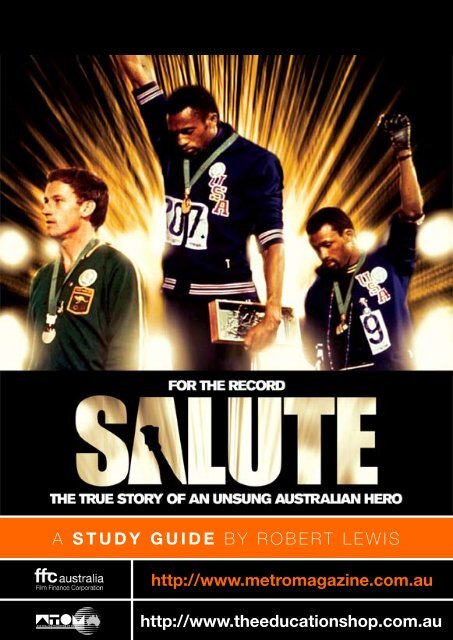
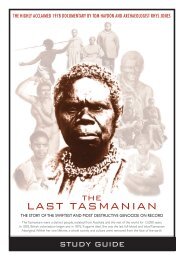

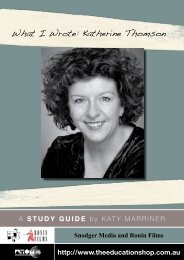
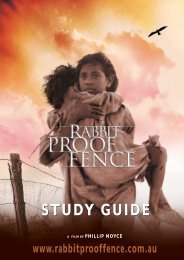

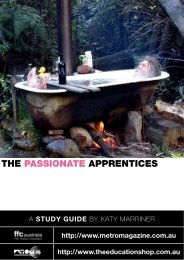
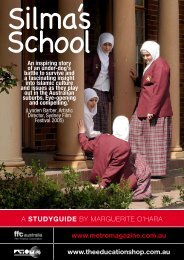
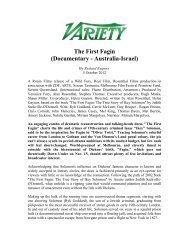

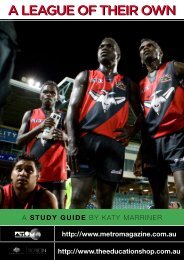
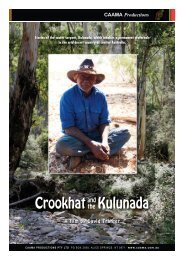
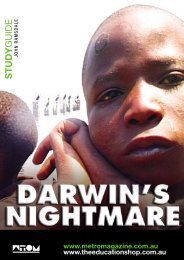
![to download FROHE OSTERN! [HAPPY EASTER!] - Ronin Films](https://img.yumpu.com/33740736/1/184x260/to-download-frohe-ostern-happy-easter-ronin-films.jpg?quality=85)
